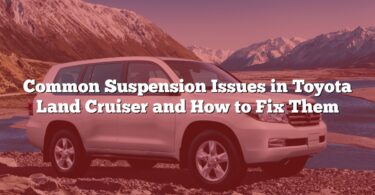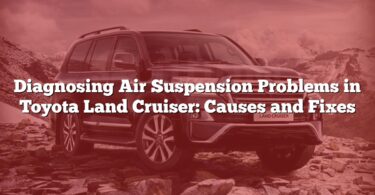Driving a Toyota Land Cruiser up a steep hill should be a seamless experience, but power loss can turn it into a frustrating challenge. This guide explores the most common causes behind this issue and provides practical, step-by-step solutions to restore your vehicle’s performance. Whether it’s a clogged air filter, faulty sensors, or transmission troubles, understanding the problem is the first step to a reliable fix. Let’s dive in and get your Land Cruiser running smoothly again, even on the toughest inclines.
Comprehensive Guide to Diagnosing Power Loss in Hills with a Toyota Land Cruiser: 49 Causes and Solutions
| N° | Problem/Cause | Solution |
|---|---|---|
| 1 | Clogged air filter | Replace the air filter. |
| 2 | Faulty mass airflow sensor (MAF) | Clean or replace the MAF sensor. |
| 3 | Clogged fuel filter | Replace the fuel filter. |
| 4 | Weak fuel pump | Replace the fuel pump. |
| 5 | Dirty or clogged injectors | Use a fuel system cleaner or clean injectors manually. |
| 6 | Turbocharger malfunction | Inspect and repair or replace the turbocharger. |
| 7 | Worn turbocharger components | Replace worn components or the turbocharger. |
| 8 | Faulty intercooler | Inspect and repair or replace the intercooler. |
| 9 | Vacuum leaks | Locate and repair vacuum leaks. |
| 10 | Faulty throttle position sensor (TPS) | Replace the TPS. |
| 11 | Worn spark plugs | Replace the spark plugs. |
| 12 | Faulty ignition coils | Replace the ignition coils. |
| 13 | Low compression in cylinders | Perform a compression test and address causes like worn rings or valves. |
| 14 | Engine timing issues | Adjust or repair timing components. |
| 15 | Dirty or faulty EGR valve | Clean or replace the EGR valve. |
| 16 | Blocked catalytic converter | Clean or replace the catalytic converter. |
| 17 | Exhaust system restriction | Inspect and clear obstructions in the exhaust system. |
| 18 | Faulty oxygen sensors | Replace oxygen sensors. |
| 19 | Faulty MAP sensor | Replace the MAP sensor. |
| 20 | Overheating engine | Check cooling system and repair as necessary. |
| 21 | Insufficient oil pressure | Check oil level and pump; address leaks or pump issues. |
| 22 | Faulty transmission | Inspect and repair or replace transmission. |
| 23 | Slipping clutch (manual transmission) | Replace the clutch. |
| 24 | Worn torque converter (automatic transmission) | Replace the torque converter. |
| 25 | Low transmission fluid | Check and refill transmission fluid. |
| 26 | Faulty drivetrain components | Inspect and repair or replace drivetrain components. |
| 27 | Differential issues | Inspect and repair or replace differential. |
| 28 | Worn or underinflated tires | Inflate or replace tires as necessary. |
| 29 | Heavy vehicle load | Reduce load weight. |
| 30 | Fuel quality issues | Use high-quality fuel. |
| 31 | Faulty ECU or engine control unit | Diagnose and repair or replace the ECU. |
| 32 | Faulty sensors (general) | Diagnose and replace malfunctioning sensors. |
| 33 | Engine misfires | Address underlying causes like ignition or fuel system issues. |
| 34 | Dirty or degraded engine oil | Change the engine oil and filter. |
| 35 | Corroded electrical connections | Clean and repair electrical connections. |
| 36 | Faulty alternator | Replace the alternator. |
| 37 | Battery issues | Replace or recharge the battery. |
| 38 | Malfunctioning fuel pressure regulator | Replace the fuel pressure regulator. |
| 39 | Worn timing belt or chain | Replace the timing belt or chain. |
| 40 | Faulty crankshaft position sensor | Replace the crankshaft position sensor. |
| 41 | Faulty camshaft position sensor | Replace the camshaft position sensor. |
| 42 | Incorrect fuel-air mixture | Diagnose and adjust the fuel-air mixture. |
| 43 | Carbon buildup on fuel injectors | Use a fuel system cleaner or clean injectors manually. |
| 44 | Slow coolant loss | Locate and repair coolant system leaks. |
| 45 | Glycol on spark plug electrodes | Inspect for head gasket failure and replace as necessary. |
| 46 | White smoke after a cold start | Check for coolant leaks or head gasket failure. |
| 47 | Rough idle for a short time after a cold start | Check ignition and fuel systems for issues. |
| 48 | Engine overheating under heavy load | Improve cooling system efficiency or reduce load. |
| 49 | Poor fuel system maintenance | Perform regular fuel system cleaning and maintenance. |
Detailed Guide to Diagnosing Power Loss in Hills with a Toyota Land Cruiser: 49 Causes and Solutions
1. Clogged Air Filter
- Reason:
- Dust and debris block airflow, reducing oxygen supply to the engine.
- Restricted airflow results in poor combustion and decreased engine power.
- Solution:
- Replace the air filter.
- Steps:
- Locate the air filter housing in the engine bay.
- Open the housing and remove the old filter.
- Insert a new air filter and securely close the housing.
2. Faulty Mass Airflow Sensor (MAF)
- Reason:
- The sensor fails to accurately measure incoming air.
- Incorrect data leads to an improper air-fuel mixture.
- Solution:
- Clean or replace the MAF sensor.
- Steps:
- Disconnect the MAF sensor from the intake system.
- Use a MAF sensor cleaner to remove debris.
- Reconnect or replace the sensor if cleaning doesn’t work.
3. Clogged Fuel Filter
- Reason:
- Dirt and contaminants block fuel flow to the engine.
- Insufficient fuel leads to poor performance and power loss.
- Solution:
- Replace the fuel filter.
- Steps:
- Locate the fuel filter near the fuel tank or engine bay.
- Disconnect the fuel lines carefully.
- Replace the old filter with a new one.
4. Weak Fuel Pump
- Reason:
- Low pressure prevents adequate fuel delivery to the engine.
- This results in inefficient combustion and poor acceleration.
- Solution:
- Replace the fuel pump.
- Steps:
- Depressurize the fuel system by removing the fuel pump relay.
- Access the fuel pump (often in the fuel tank).
- Replace the pump and test fuel pressure.
5. Dirty or Clogged Injectors
- Reason:
- Carbon buildup or debris blocks the injector nozzles.
- This disrupts the fuel spray pattern, causing incomplete combustion.
- Solution:
- Use a fuel system cleaner or manually clean the injectors.
- Steps:
- Add a fuel system cleaner to the fuel tank during refueling.
- For severe clogs, remove injectors for professional cleaning.
6. Turbocharger Malfunction
- Reason:
- Turbochargers fail due to wear, oil contamination, or overheating.
- A faulty turbo reduces power output.
- Solution:
- Inspect and repair or replace the turbocharger.
- Steps:
- Check for unusual noises or reduced boost pressure.
- Inspect the turbo for oil leaks or damaged fins.
- Replace worn components or the entire unit.
7. Worn Turbocharger Components
- Reason:
- Bearings or seals wear out, causing inefficiencies.
- Damaged components lead to power loss and potential failure.
- Solution:
- Replace worn components or the turbocharger.
8. Faulty Intercooler
- Reason:
- Damaged or leaking intercoolers fail to cool compressed air.
- Hot air reduces engine efficiency and power.
- Solution:
- Inspect and repair or replace the intercooler.
- Steps:
- Check for leaks or blockages.
- Replace the intercooler if damage is extensive.
9. Vacuum Leaks
- Reason:
- Air leaks disrupt the intake manifold pressure.
- This causes incorrect fuel-air mixture and power loss.
- Solution:
- Locate and repair vacuum leaks.
- Steps:
- Inspect hoses and connections for cracks.
- Replace damaged hoses or gaskets.
10. Faulty Throttle Position Sensor (TPS)
- Reason:
- The TPS fails to signal throttle position accurately.
- This results in erratic acceleration and reduced power.
- Solution:
- Replace the TPS.
11. Worn Spark Plugs
- Reason:
- Worn electrodes cause incomplete ignition of the air-fuel mixture.
- This leads to engine misfires and power loss.
- Solution:
- Replace the spark plugs.
- Steps:
- Remove the old spark plugs using a spark plug socket.
- Check the gap on new plugs and install them.
12. Faulty Ignition Coils
- Reason:
- Ignition coils fail to provide adequate spark to the plugs.
- This causes misfires and poor engine performance.
- Solution:
- Replace faulty ignition coils.
13. Low Compression in Cylinders
- Reason:
- Worn piston rings or valves reduce cylinder pressure.
- Low compression results in inefficient combustion.
- Solution:
- Perform a compression test to identify affected cylinders.
- Repair worn rings or valves.
14. Engine Timing Issues
- Reason:
- Incorrect timing disrupts combustion synchronization.
- This causes power loss and engine knocking.
- Solution:
- Adjust or repair timing components.
- Steps:
- Inspect the timing belt or chain.
- Replace if worn or damaged.
15. Dirty or Faulty EGR Valve
- Reason:
- Carbon buildup blocks the EGR valve.
- This disrupts the flow of exhaust gases and combustion efficiency.
- Solution:
- Clean or replace the EGR valve.
16. Blocked Catalytic Converter
- Reason:
- Excessive carbon buildup restricts exhaust flow.
- This causes backpressure in the engine, reducing performance.
- Solution:
- Clean or replace the catalytic converter.
- Steps:
- Use a catalytic converter cleaner by adding it to the fuel tank.
- For severe blockage, remove the converter and inspect for physical damage.
- Replace the converter if cleaning does not resolve the issue.
17. Exhaust System Restriction
- Reason:
- Damaged or clogged exhaust pipes restrict gas flow.
- This leads to inefficient engine operation and power loss.
- Solution:
- Inspect and clear obstructions in the exhaust system.
- Steps:
- Check for dents or blockages in the exhaust pipes.
- Repair or replace damaged sections of the exhaust.
18. Faulty Oxygen Sensors
- Reason:
- A malfunctioning oxygen sensor sends incorrect data to the ECU.
- This results in an improper air-fuel mixture.
- Solution:
- Replace oxygen sensors.
- Steps:
- Locate the oxygen sensor in the exhaust system.
- Disconnect the sensor and install a new one.
19. Faulty MAP Sensor
- Reason:
- A defective MAP sensor gives inaccurate pressure readings.
- This disrupts engine timing and fuel delivery.
- Solution:
- Replace the MAP sensor.
20. Overheating Engine
- Reason:
- A failing cooling system causes the engine to overheat under load.
- This reduces engine efficiency and power.
- Solution:
- Check and repair the cooling system.
- Steps:
- Inspect the radiator and coolant hoses for leaks.
- Check the thermostat and water pump for proper operation.
- Refill coolant and ensure proper levels.
21. Insufficient Oil Pressure
- Reason:
- Low oil pressure leads to poor lubrication.
- This increases friction and reduces engine efficiency.
- Solution:
- Check oil level and address leaks or pump issues.
- Steps:
- Inspect for visible oil leaks.
- Refill or change the oil and filter.
- Test the oil pump if the issue persists.
22. Faulty Transmission
- Reason:
- Transmission issues cause poor power delivery to the wheels.
- This results in reduced performance on inclines.
- Solution:
- Inspect and repair or replace the transmission.
- Steps:
- Check for slipping or delayed gear shifts.
- Service the transmission or replace damaged components.
23. Slipping Clutch (Manual Transmission)
- Reason:
- A worn clutch fails to transmit engine power to the drivetrain effectively.
- Solution:
- Replace the clutch.
- Steps:
- Remove the transmission to access the clutch assembly.
- Replace the clutch plate, pressure plate, and release bearing.
24. Worn Torque Converter (Automatic Transmission)
- Reason:
- A failing torque converter reduces power transfer in automatic vehicles.
- Solution:
- Replace the torque converter.
25. Low Transmission Fluid
- Reason:
- Insufficient fluid causes overheating and inefficient gear operation.
- Solution:
- Check and refill transmission fluid.
- Steps:
- Locate the transmission dipstick and check fluid levels.
- Add manufacturer-recommended transmission fluid if needed.
26. Faulty Drivetrain Components
- Reason:
- Damaged components like driveshafts or CV joints reduce power delivery.
- Solution:
- Inspect and repair or replace faulty components.
27. Differential Issues
- Reason:
- Worn or damaged differentials reduce power transfer to the wheels.
- Solution:
- Inspect and repair or replace the differential.
28. Worn or Underinflated Tires
- Reason:
- Poor tire condition increases rolling resistance.
- Solution:
- Inflate or replace tires as necessary.
- Steps:
- Use a tire pressure gauge to check inflation levels.
- Inflate tires to manufacturer-recommended pressure.
- Replace tires if treads are worn.
29. Heavy Vehicle Load
- Reason:
- Excessive weight strains the engine and reduces power.
- Solution:
- Reduce the load weight.
30. Fuel Quality Issues
- Reason:
- Low-quality or contaminated fuel disrupts combustion efficiency.
- Solution:
- Use high-quality fuel.
31. Faulty ECU or Engine Control Unit
- Reason:
- Malfunctioning ECU causes improper engine management.
- Solution:
- Diagnose and repair or replace the ECU.
32. Faulty Sensors (General)
- Reason:
- Sensors like crankshaft or camshaft position sensors fail, disrupting timing.
- Solution:
- Diagnose and replace faulty sensors.
33. Engine Misfires
- Reason:
- Ignition or fuel system issues cause misfires.
- Solution:
- Identify and repair the underlying issue (spark plugs, injectors, etc.).
34. Dirty or Degraded Engine Oil
- Reason:
- Dirty oil increases engine friction.
- Solution:
- Change the engine oil and filter.
35. Corroded Electrical Connections
- Reason:
- Poor connections disrupt sensor and component operation.
- Solution:
- Clean and repair electrical connections.
36. Faulty Alternator
- Reason:
- A failing alternator impacts electrical system efficiency.
- Solution:
- Replace the alternator.
37. Battery Issues
- Reason:
- Weak batteries reduce starting power and electrical system performance.
- Solution:
- Recharge or replace the battery.
38. Malfunctioning Fuel Pressure Regulator
- Reason:
- A faulty regulator causes inconsistent fuel pressure.
- Solution:
- Replace the fuel pressure regulator.
39. Worn Timing Belt or Chain
- Reason:
- A worn belt or chain disrupts engine timing.
- Solution:
- Replace the timing belt or chain.
40. Faulty Crankshaft Position Sensor
- Reason:
- The sensor fails to provide accurate engine speed data.
- Solution:
- Replace the crankshaft position sensor.
41. Faulty Camshaft Position Sensor
- Reason:
- This sensor affects valve timing.
- Solution:
- Replace the camshaft position sensor.
Preventing Future Issues
To ensure your Toyota Land Cruiser performs optimally and avoids power loss in the future, follow these preventive steps:
- Regular Maintenance
- Perform scheduled maintenance according to the manufacturer’s recommendations.
- Include oil changes, filter replacements, and system inspections.
- Inspect Air and Fuel Filters
- Check the air filter every 15,000 to 30,000 miles, depending on driving conditions.
- Replace the fuel filter as per the vehicle’s maintenance schedule to prevent clogs.
- Monitor Fluid Levels
- Regularly check and maintain appropriate levels of engine oil, coolant, and transmission fluid.
- Use only manufacturer-recommended fluids to ensure compatibility and performance.
- Clean Essential Components
- Clean the mass airflow sensor (MAF), throttle body, and injectors periodically to prevent buildup.
- Use fuel system cleaners every 3,000 to 5,000 miles.
- Inspect and Replace Worn Parts
- Check spark plugs, ignition coils, belts, and hoses for wear.
- Replace them as needed to prevent breakdowns and ensure efficiency.
- Keep Tires in Good Condition
- Regularly check tire pressure and keep it within the recommended range.
- Replace worn or damaged tires to ensure proper traction and reduce strain on the engine.
- Use High-Quality Fuel
- Always refuel with high-quality gasoline or diesel from trusted suppliers.
- Avoid using low-grade or contaminated fuel that can damage engine components.
- Maintain the Cooling System
- Flush and replace coolant according to the maintenance schedule.
- Inspect the radiator, water pump, and thermostat for potential issues.
- Perform Regular Diagnostics
- Use an OBD-II scanner to monitor and clear any fault codes.
- Address warning lights promptly to prevent minor issues from escalating.
- Reduce Strain on the Vehicle
- Avoid overloading the vehicle, especially during uphill driving.
- Shift to appropriate gears and maintain a steady speed to reduce stress on the engine.
By following these preventive measures, you can minimize the risk of power loss and ensure your Land Cruiser operates reliably in any condition.







